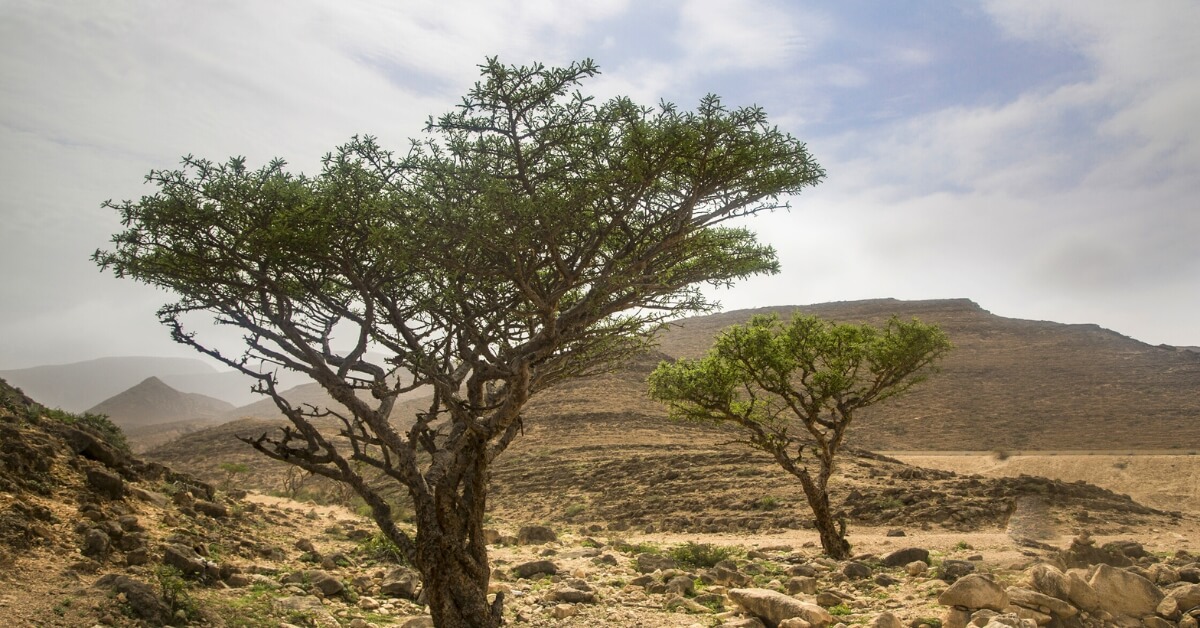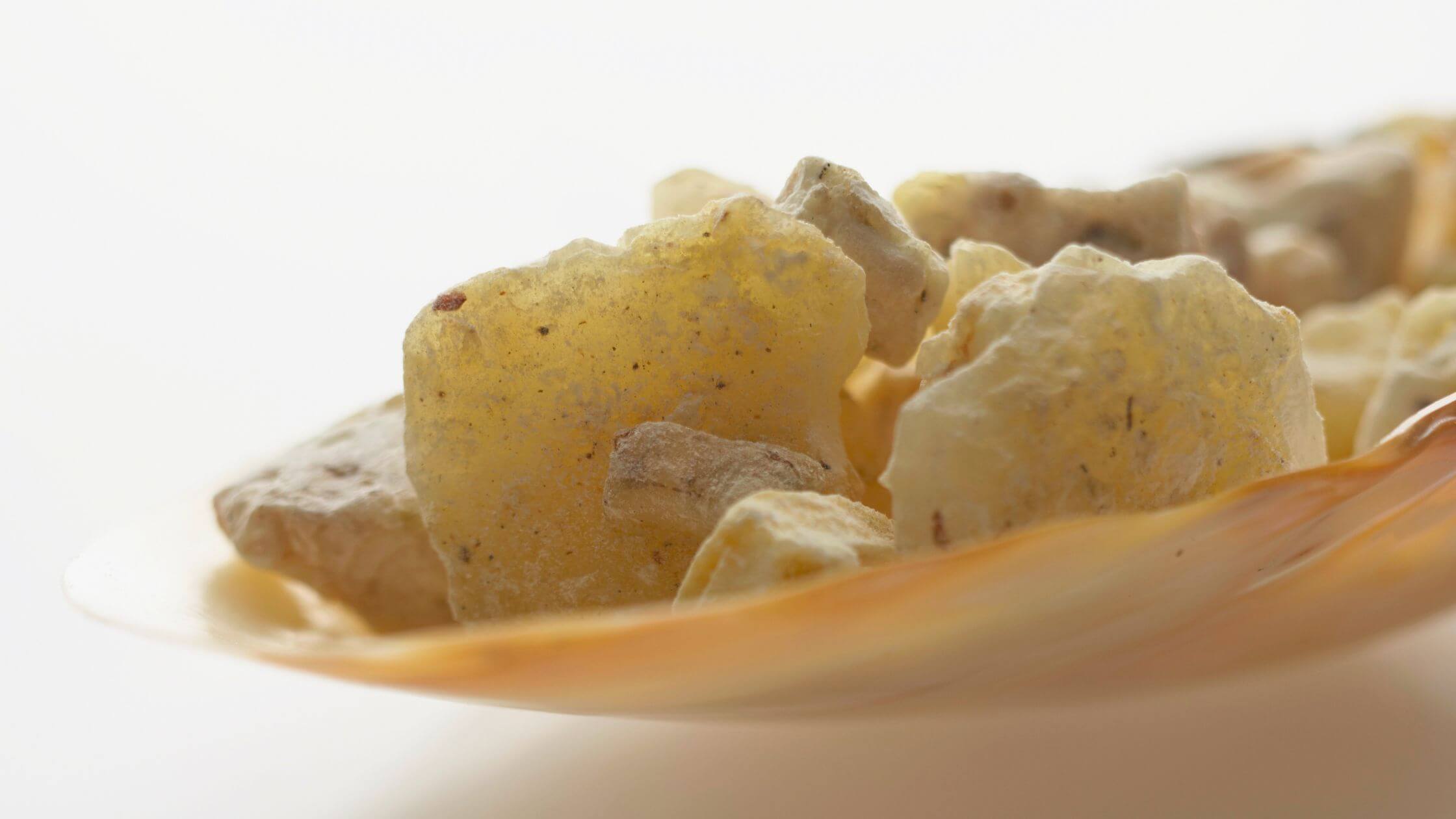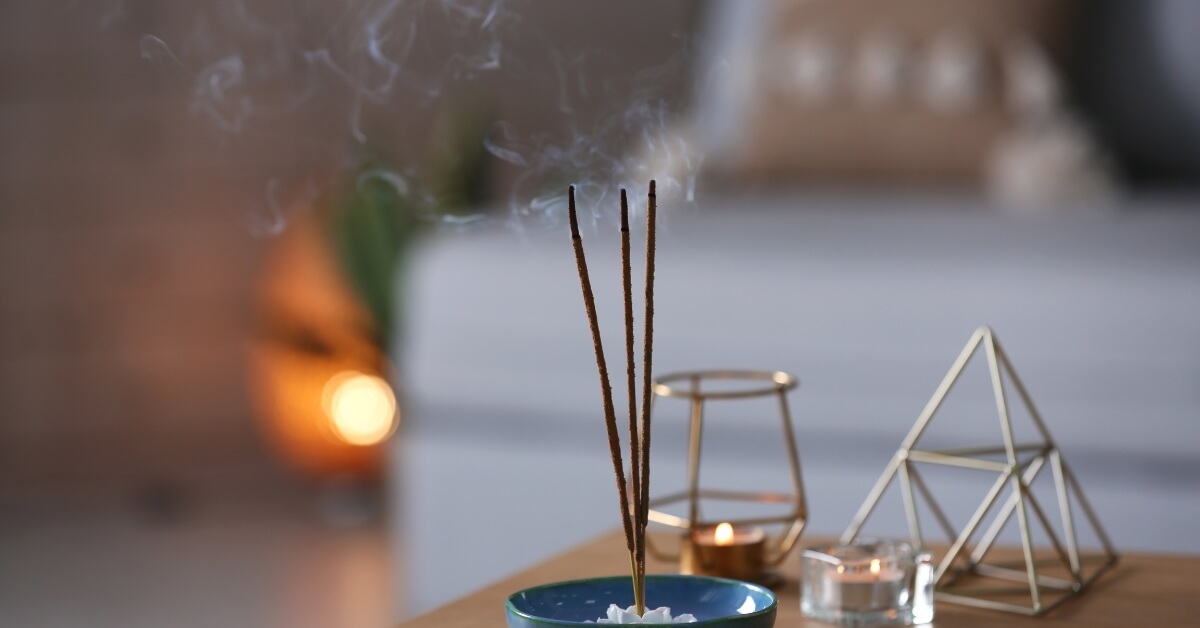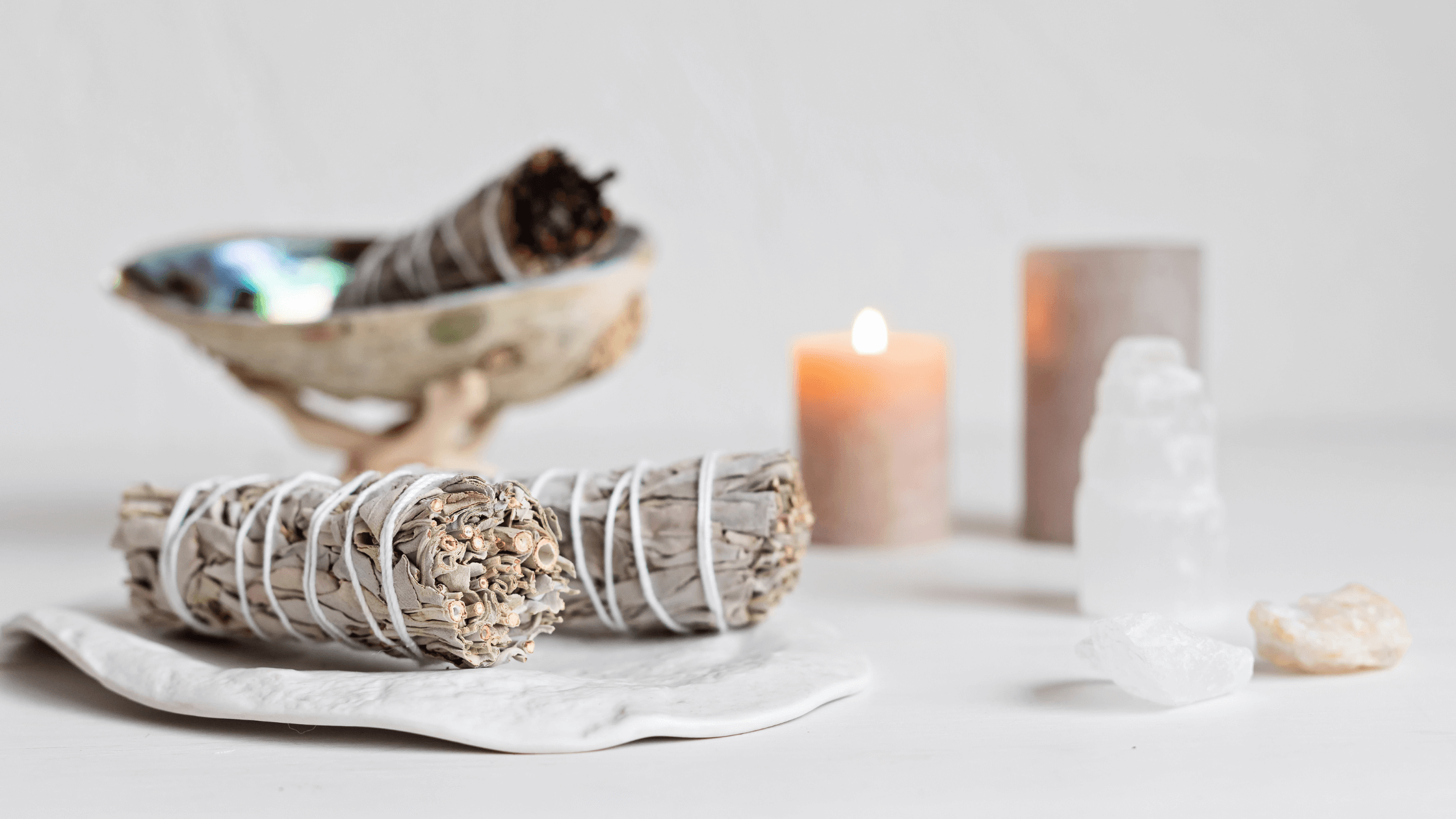Introduction:
The Frankincense Tree, bearing its characteristic gnarled branches and infused with a deeply spiritual aura, has gracefully endured through millennia. Beyond being a mere fixture in the arid landscapes where it thrives, this tree is a woven fabric of tales and traditions, reaching back to the dawn of human civilization.
From the sacred halls of ancient Egyptian temples to the bustling marketplaces along the Silk Road, the Frankincense Tree has left indelible imprints on the annals of history. Its resonance is not merely owed to the coveted aromatic resin it yields but also to the myriad of uses and properties that have dubbed it a universal healer. As we embark on this exploration, we’ll traverse through time, delving into the eight profound properties that lend the Frankincense Tree its esteemed stature in cultures worldwide.
1. The Ancient Healer:
Since time immemorial, the Frankincense Tree has been an emblem of healing, spirituality, and prosperity. Its legacy is deeply rooted in ancient civilizations, where it was revered not just for its aromatic qualities but also for its myriad of medicinal properties.
The resin harvested from the Frankincense Tree, often called ‘liquid gold’, has made its mark across various cultures. Ancient Egyptians utilized it in the mummification process, acknowledging its preservative and aromatic characteristics. This resin, considered a gift fit for kings and deities, found its place in religious rituals and as an essential component in traditional medicine.
Historically, the properties of the Frankincense Tree played a significant role in the health practices of civilizations like the Greeks, Romans, and Indians. Renowned Greek king, Alexander the Great, is believed to have sought after the Frankincense Tree, wanting to harness its therapeutic benefits. Hippocrates, the father of medicine, made references to the use of frankincense in treating ailments, highlighting its potent healing qualities.
Moreover, the Frankincense Tree was a symbol of divinity and was extensively mentioned in religious texts. Its presence in the Bible, where it was one of the gifts brought to baby Jesus by the Magi, accentuates its esteemed stature in ancient times.
Today, while science continues to explore the myriad benefits rooted in the resin of the Frankincense Tree, the echoes of its past reverberate, reminding us of its timeless appeal. With each application of Frankincense Resin Hojari – Premium Quality, we not only indulge in its therapeutic prowess but also connect with centuries of ancestral wisdom.
The Frankincense Tree, with its deep-seated legacy, stands as a testament to nature’s unparalleled ability to heal, soothe, and rejuvenate. It’s a bridge that connects modern-day enthusiasts with ancient practices, making history palpable with every whiff and application.
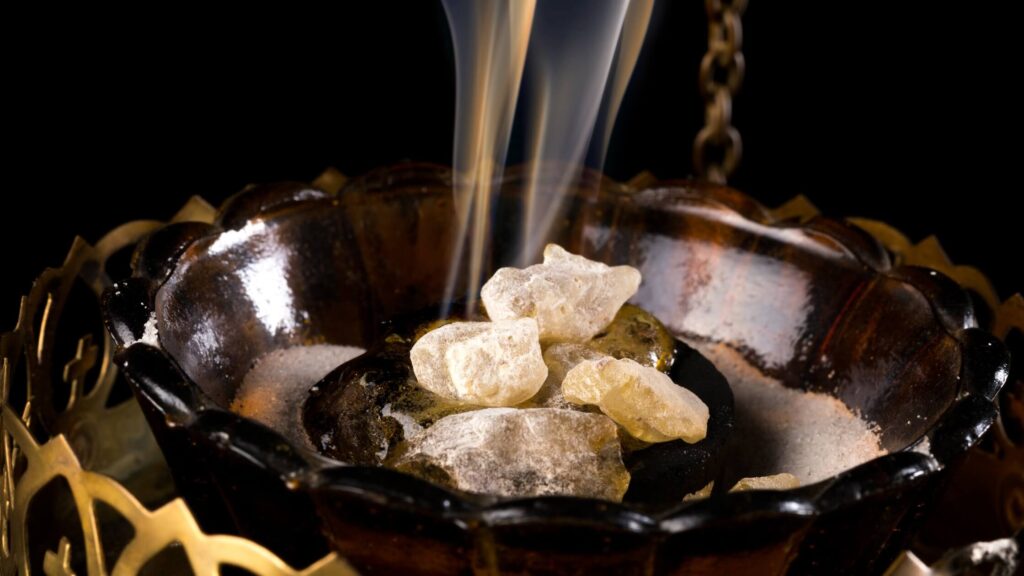

Frankincense Resin Burning
2. Spiritual Significance:
The story of the Frankincense Tree transcends mere historical events. Its significance entwines with the threads of spirituality, reflecting the depths of human faith and our eternal quest for the divine. It’s not just a tree; it’s an emblem of spiritual devotion.
In the vast tapestry of religious practices, the resin of the Frankincense Tree holds a special place. The aroma, when burned, is believed to purify the surroundings, ward off evil spirits, and usher in a sense of tranquility and peace. This is why it has been so ardently embraced by multiple faiths over the millennia.
- Christianity: Perhaps one of the most renowned instances in Christian scripture is the account of the Three Wise Men or Magi, who brought gifts for the infant Jesus. Among these treasured gifts was frankincense, a testament to its esteemed position. It symbolized Christ’s role as a priest, sanctifying and interceding on behalf of humanity. Even today, many Christian churches incorporate frankincense in their liturgical rites, filling sanctuaries with its mesmerizing aroma, believed to ascend as prayers to the heavens.
- Buddhism: Buddhist practices, especially within the realms of meditation, have often involved the burning of frankincense. The resin’s calming scent from the Frankincense Tree aids in focusing the mind, allowing practitioners to delve deeper into their meditative states.
- Islam: In Islamic traditions, frankincense, locally known as ‘Luban’, is frequently used in homes and mosques. The serene environment it fosters is conducive to prayer and reflection, allowing a deeper connection with the divine.
- Hinduism: The rites and rituals in Hindu temples often incorporate the use of frankincense, believing its aroma purifies the environment and aids in the spiritual upliftment of devotees.
Beyond structured religious practices, the Frankincense Tree has found its way into the personal spiritual endeavors of many. Meditation centers, yoga studios, and personal altars often bear the lingering scent of frankincense. Its ability to center the mind and clear away distractions has made it an invaluable tool for those on spiritual quests.
In an ever-evolving world where new practices emerge, and the old ones are redefined, the Frankincense Tree remains a constant. It stands as a beacon, guiding individuals on their spiritual journey, proving that some things, no matter how ancient, remain timeless in their significance.
3. The Science Behind this Treasure:
When delving into the secrets of nature, few entities encapsulate the fusion of ancient wisdom and modern science as elegantly as the Frankincense Tree. This revered tree, with its fragrant resin, has intertwined its narrative with humans since ancient times. Today, as we peel back the layers of its chemical makeup, we unveil the truth behind the age-old praises sung in its name.
For thousands of years, the Frankincense Tree has been harvested for its resin. This golden teardrop that oozes from its bark was deemed precious by ancient cultures. But what precisely in this resin invoked such respect? To answer this, we transition from mystical texts to scientific journals.
-
Chemical Constituents of the Frankincense Tree and its Resin:
Frankincense, primarily, is made up of a complex blend of chemicals. The essential oil distilled from the resin of the Frankincense Tree contains compounds like alpha-pinene, limonene, and myrcene, among others. Alpha-pinene, for example, is known for its anti-inflammatory properties, potentially explaining the resin’s historical use for treating ailments.
But that’s not all. The resin also contains boswellic acids – a component that has garnered much interest in the scientific community. These acids have shown potential anti-inflammatory and tumor-inhibiting properties. This hints at the tree’s potential in contributing to treatments and solutions in the medical world, thus, reinstating its label as an “Ancient Healer.”
-
Modern Science Validates Ancient Beliefs:
Over time, many ancient remedies fall out of favor or are discredited. Yet, the Frankincense Tree stands resilient, its historical reputation now bolstered by modern studies. Recent research has indicated that frankincense might play a pivotal role in pain management, reducing inflammation, and even in the fight against certain types of cancers.
Furthermore, studies have shed light on its potential anti-anxiety and antidepressant properties. The tranquil ambiance often associated with frankincense during meditation or spiritual practices might indeed have a chemical basis, going beyond mere placebo.
To summarize, while the ancients might not have known about boswellic acids or alpha-pinene, they recognized something intrinsically therapeutic about the Frankincense Tree. Today, science doesn’t refute but reinforces these ancient convictions. The Frankincense Tree is not just a relic of the past but a beacon for the future, as we continue to unlock and harness its profound potential.
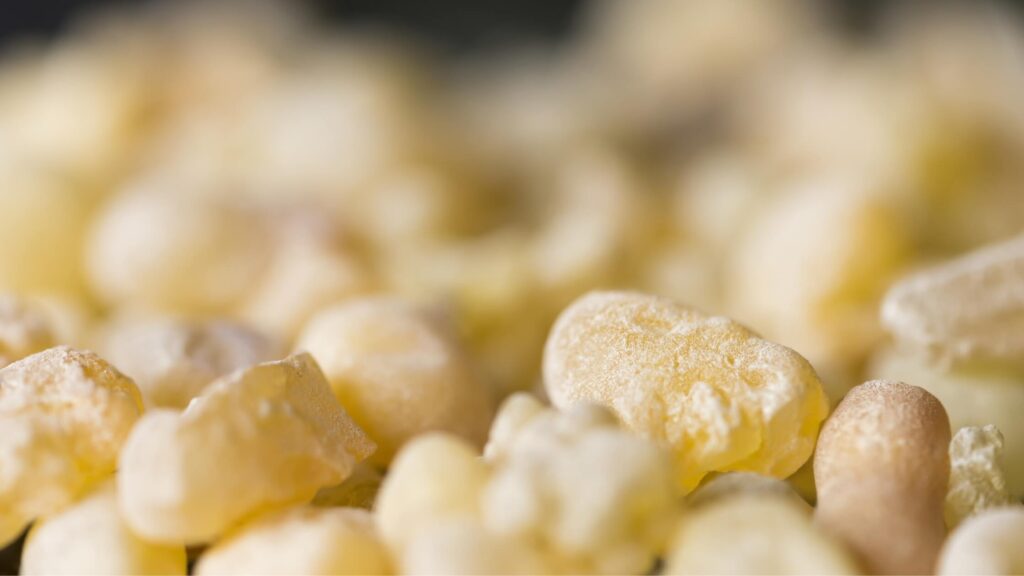

Hojari Frankincense Resin
4. A Gift from Nature: The Frankincense Resin
From the arid lands where the Frankincense Tree flourishes comes a gift revered by civilizations through millennia. The golden tears of the tree, the resin, are not just any substance; they carry with them ancient stories, rituals, and profound healing powers.
To extract this cherished substance, one must embark on an intricate journey. The bark of the Frankincense Tree is deliberately wounded, making deliberate incisions. From these scars, the tree bleeds its precious sap. As this sap touches the air, it hardens and forms droplets or tears, which we come to recognize as frankincense resin. This is a process requiring the utmost care and respect for the tree. The value of the tree isn’t just in its resin, but in its life-giving role in the ecosystem.
With multiple types of frankincense resins available, discerning the superior ones is an art. The Hojari Premium Quality Frankincense Resin stands out among them. This variant of the resin is sourced from the best Frankincense Trees. The environment in which the tree grows, the time of harvesting, and the method of extraction all play vital roles in ensuring the premium quality of the Hojari Frankincense Resin.
Each tear of the Hojari resin boasts purity and an unmatched aromatic profile. When burnt, it releases a scent that seems to transcend time and space, transporting one to ancient sacred temples and spaces where the air is thick with mysticism and reverence. This is not just the magic of the Frankincense Tree but the embodiment of the care with which the resin is sourced and processed.
The resin from the Frankincense Tree isn’t just about its fragrance. Its therapeutic properties, which are magnified in the Hojari Premium Quality variant, have been documented extensively. Beyond its profound spiritual applications, its uses span from skincare regimes to aromatherapy and even some medicinal formulations.
In essence, when one holds a piece of Authentic Frankincense Resin, they aren’t just holding a piece of tree sap. They’re holding the culmination of nature’s wonders, ancient wisdom, and a testament to humanity’s appreciation for the gifts of the Frankincense Tree.
5. Natural Aromatherapy:
From ancient temples to modern spas, the fragrance of the Frankincense Tree has continually graced humanity with its soothing and therapeutic aroma. The tradition of using this revered scent to elevate one’s spirit and heal the body can be traced back to antiquity.
-
Therapeutic Benefits of the Aroma from the Frankincense Tree:
When one thinks of aromatherapy, frankincense often emerges as a quintessential component. The fragrance emitted from the Frankincense Tree is not just pleasant but is believed to have numerous therapeutic benefits. Breathing in this aroma can induce a sense of peace, aiding in reducing anxiety, stress, and negativity. This aromatic tree’s scent is also believed to stimulate the immune system, making it a favorite choice in holistic healing practices. The terpenes and other organic compounds found in frankincense have been investigated by scientists for potential anti-inflammatory and even anti-cancer properties, giving a nod to ancient practices with a touch of modern validation.
-
Its Use in Modern Aromatherapy Practices:
In the world of modern aromatherapy, frankincense holds a place of honor. Diffusers emitting the scent of the Frankincense Tree are commonly found in meditation spaces, yoga studios, and wellness retreats, facilitating deeper relaxation and enhanced mindfulness. The essential oil derived from frankincense resin is a staple in many blends, touted for its ability to rejuvenate the skin, relax the mind, and elevate the spirit. Combining frankincense with other essential oils can amplify its effects, making it a versatile tool in any aromatherapist’s toolkit.
For anyone looking to harness nature’s power to heal and soothe, frankincense stands out as a timeless ally. Whether you’re exploring the ancient rituals or contemporary therapeutic techniques, the Frankincense Tree offers a bridge between worlds, reminding us of the interconnectedness of tradition and innovation.
6. Skincare and Beauty:
From ancient times to modern cosmetic labs, the Frankincense Tree has held a revered position in the realm of skincare and beauty. While the history books paint pictures of ancient queens and nobility indulging in the resin’s opulent essence, contemporary skincare lines pride themselves on integrating this age-old gem into their solutions.
The Frankincense Tree is more than just a bearer of aromatic resin; it’s a gateway to rejuvenated skin. With each drop of oil extracted from its bark or every ounce of its powdered resin, there lies a promise of clearer, brighter, and more youthful skin. But how did this ancient tree gain such popularity in the realm of modern skincare?
Frankincense in Cosmetic Products:
Modern beauty regimens are all about harnessing nature’s best, and Frankincense stands as a testament to this trend. Serums, creams, and essential oils infused with extracts from the Frankincense Tree are increasingly gaining traction in the market. Their claims? To combat signs of aging, reduce the appearance of scars, and provide an overall soothing effect to irritated skin. Such is the potency of Frankincense that even a few drops of its essential oil in a carrier oil or cream can revitalize skin texture, making it a favorite ingredient for many premium cosmetic brands.
Benefits for the Skin:
The therapeutic properties of the Frankincense Tree are not limited to its aromatic prowess. On a cellular level, Frankincense has been known to promote the generation of new cells, keeping the skin firm and youthful. It’s also an astringent, meaning it helps tighten the skin, reducing wrinkles and fine lines. Furthermore, its anti-inflammatory attributes are ideal for calming breakouts and reducing redness, making it a savior for those with sensitive or acne-prone skin.
To say the Frankincense Tree has revolutionized skincare would be no overstatement. Its manifold benefits, rooted in centuries of empirical evidence and now backed by modern science, make it an invaluable addition to any skincare routine. As the cosmetic industry continues to evolve, one thing remains certain: Frankincense’s legacy as a skincare elixir is here to stay
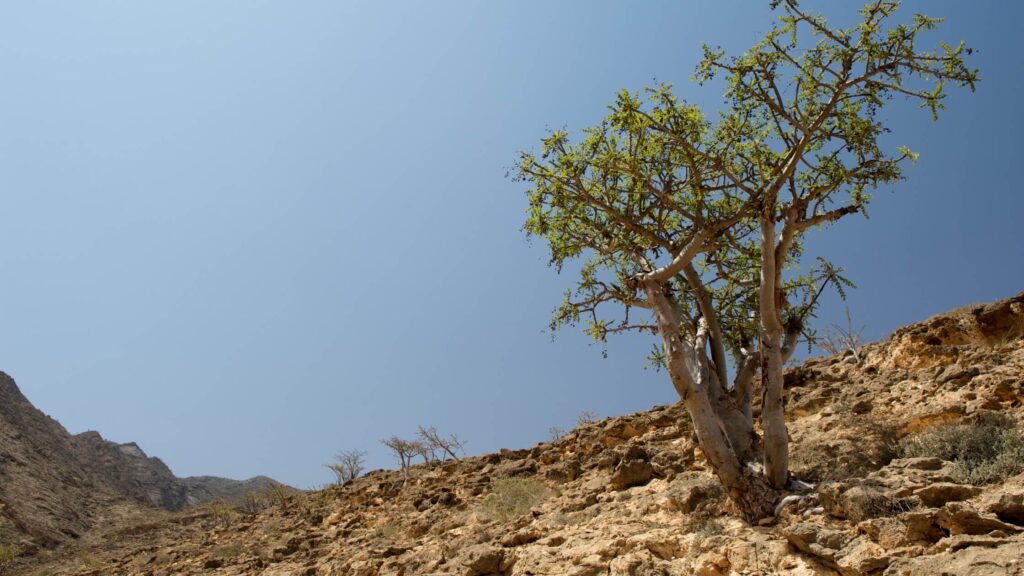

Frankincense Tree In Dhofar Mountains
7. Beyond Wellness: Economic Significance:
In the vast expanses of the desert regions where the Frankincense Tree flourishes, there’s an intertwined tale of nature and economy. It’s not just a story of spiritual awakening or therapeutic benefits. The Frankincense Tree plays a pivotal role in sustaining communities, adding economic value and ensuring their livelihood.
The Frankincense Tree, scientifically known as Boswellia, primarily grows in the arid regions of Oman, Yemen, Somalia, and parts of India. These areas have, for centuries, been the global hubs for frankincense trade. Beyond its aromatic resin, the tree serves as an economic pillar for these regions. Every part of the Frankincense Tree, from its bark to its resin, holds value, either in the form of medicine, cosmetics, or direct trade.
One cannot overstate the importance of sustainable trade in the realm of frankincense. With the soaring global demand, there’s an ever-increasing pressure on these trees. Over-harvesting can lead to their depletion, threatening not only the ecological balance but also the primary source of income for many local communities. Sustainable trade ensures that the Frankincense Tree is not over-exploited. It means that while the world gets its share of this precious resin, the tree continues to thrive and support the local ecosystem.
Local communities have, over generations, perfected the art of tapping the tree for its resin without causing it harm. They understand the rhythms of nature, knowing when to extract and when to let the tree rest. This traditional knowledge, combined with modern sustainable practices, is what ensures that the Frankincense Tree continues to be an economic asset for years to come.
Furthermore, as consumers become more conscious about the products they use and their origins, there’s a growing demand for ethically sourced and sustainably traded products. This trend works in favor of these local communities, allowing them to command better prices for their harvest, provided it’s done sustainably.
In this context, understanding the economic significance of the Frankincense Tree is as crucial as appreciating its therapeutic or spiritual value. The tree not only heals bodies and souls but also nurtures communities, providing them with a livelihood and an identity. It’s a testament to how nature, when respected and cared for, gives back manifold.
By valuing the sustainable and authentic products, we don’t just get the best quality but also contribute to the well-being of these communities. For instance, the Hojari Premium Quality Frankincense Resin stands as an epitome of this balance between top-notch quality and ethical sourcing, bringing the essence of the Frankincense Tree right to our homes while ensuring the preservation of its native land and people.
In conclusion, the Frankincense Tree is more than just an ancient healer; it’s a lifeline for many, an economic pillar that stands tall, benefiting all those who come in its shade.
8. Conservation Concerns:
The Frankincense Tree, with its centuries of historical and cultural significance, is not merely a symbol of spirituality and healing but also a testament to nature’s bounty. However, the same acclaim and demand that made this tree revered are posing threats to its very existence today.
The vast stretches of arid landscapes where the Frankincense Tree thrives are now facing the repercussions of over-exploitation. Local communities, drawn by the economic benefits, sometimes resort to tapping the trees more frequently than they should. This over-tapping can weaken the trees, making them more susceptible to diseases and pests.
The importance of sustainable harvesting cannot be stressed enough. Each Frankincense Tree requires adequate time between tappings to ensure it remains healthy and robust. Not adhering to these intervals jeopardizes the tree’s health and resin quality. As the global demand for frankincense resin surges, there’s a corresponding pressure on these trees, making sustainable practices even more crucial.
However, the threats to the Frankincense Tree aren’t just from over-harvesting. Habitat loss, driven by agricultural expansion, urbanization, and even climate change, further shrinks the regions where these trees can grow. Additionally, as these trees become rarer, their genetic diversity is at risk, making them more vulnerable to pests, diseases, and changing environmental conditions.
The silver lining in this looming cloud is the growing global awareness about the conservation of this precious tree. Efforts are now in motion to cultivate frankincense trees under controlled conditions, ensuring that the natural populations aren’t overly strained. Educational programs in regions where the Frankincense Tree is native are teaching local communities about the importance of sustainable tapping practices. International collaborations are focusing on creating protected areas where these trees can thrive without the immediate threats of over-exploitation.
In conclusion, while the Frankincense Tree has served humanity selflessly for ages, it is now humanity’s turn to give back. Recognizing the importance of this ancient healer, respecting its limits, and actively participating in its conservation are crucial steps in ensuring that future generations can also benefit from the myriad wonders of the Frankincense Tree.
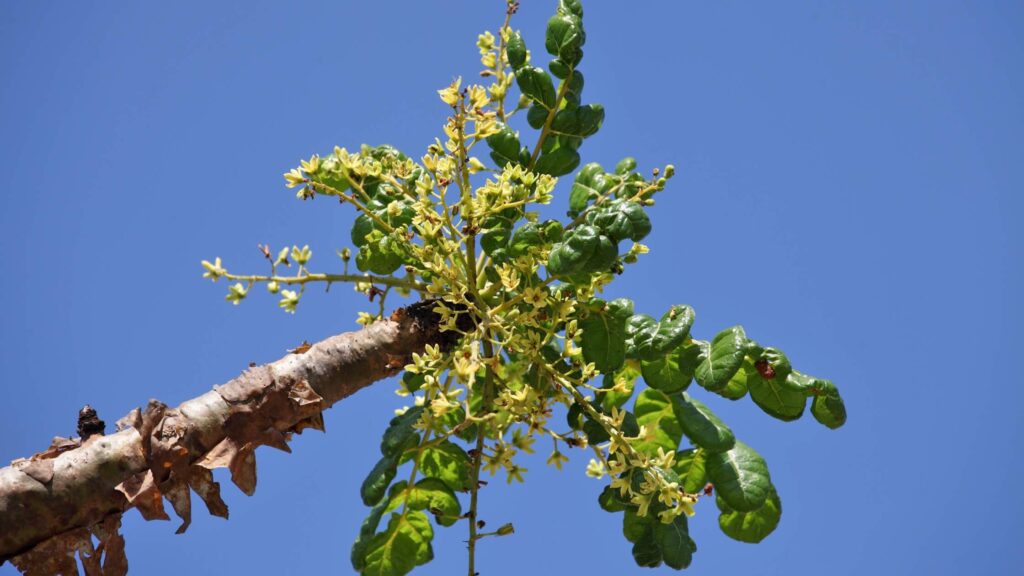

Flowers of Frankincense Tree
Conclusion:
In our journey to unveil the mysteries and wonders of the Frankincense Tree, we’ve traversed through ancient histories, spiritual realms, and the depths of scientific validation. This tree isn’t merely a provider of aromatic resins but stands as a testament to the intertwining of nature with human culture and wellbeing.
The Frankincense Tree is not just rooted in the soils of the regions it graces but also firmly rooted in the annals of human civilization. From its undeniable role in spiritual ceremonies to its promising potential in modern healthcare and beauty, it’s evident that this tree’s importance transcends time.
As we’ve gleaned insights into the therapeutic aroma, the value in skincare, and the economic boon it represents for local communities, the tree’s versatility becomes indisputably clear. And yet, with all these benefits come responsibilities. The Frankincense Tree, like many treasures of nature, faces threats from unsustainable harvesting methods and environmental changes.
It becomes imperative for us, as beneficiaries of its bounties, to advocate for its protection. Every product we purchase, every piece of information we share, and every decision we make can contribute to the continued survival and thriving of this ancient healer. When we talk about the Frankincense Tree, we’re not just discussing a plant; we’re addressing a legacy—a legacy that we must pass down to future generations intact.
So, as we conclude our deep dive into the world of the Frankincense Tree, let it be with a renewed sense of respect and commitment. A commitment to value, protect, and sustainably utilize the manifold gifts of this timeless gem of nature.
